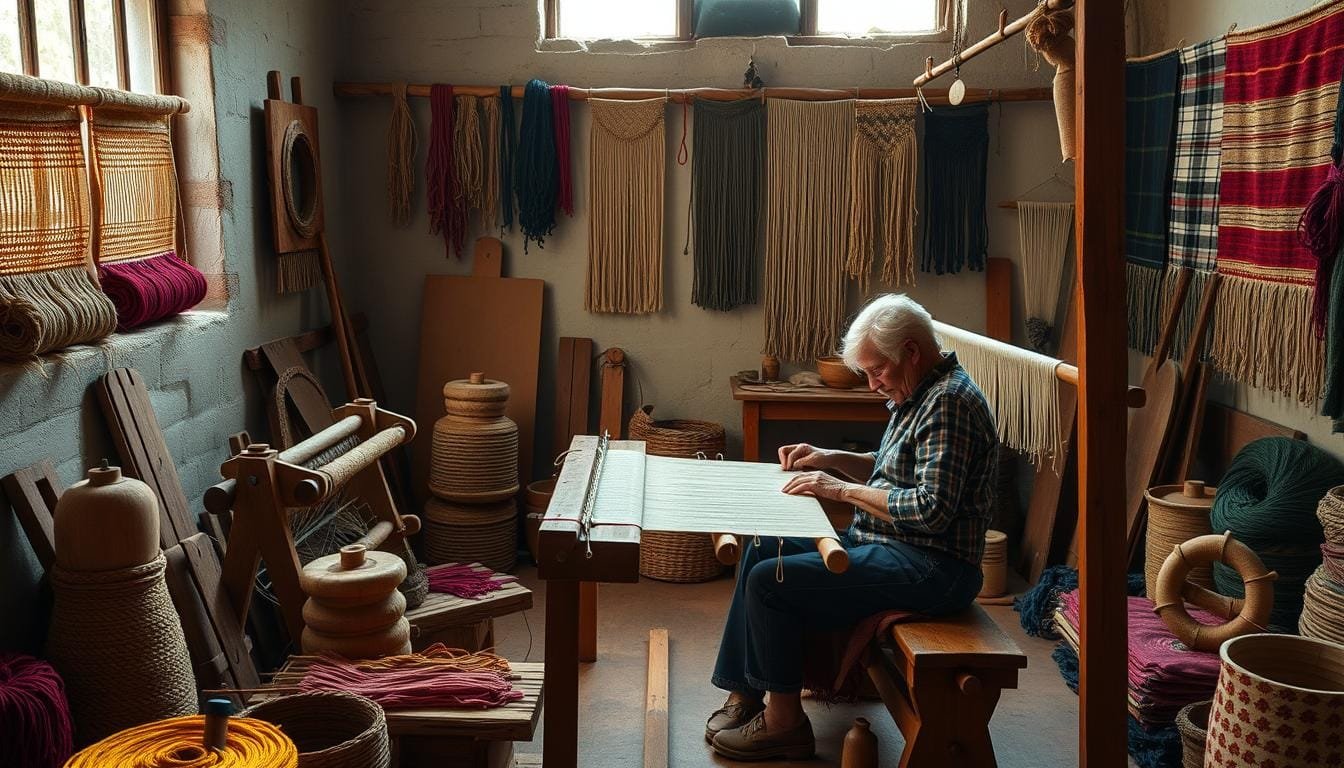USA weaving shows the nation’s deep cultural richness. It spans from ancient Native American methods to today’s industrial weaving. American textiles have become a big part of our lives.
Textile art in the USA goes way back. The oldest textiles found in North America are 8,000 years old. This shows how weaving has changed over time.
Weaving in the USA is more than just making clothes. It’s about creativity, sharing cultures, and staying strong. The Flying Shuttle was invented in 1733. Enslaved Black women also played a big role in weaving history.
Today, weaving is still important and changing. People like Karen are mixing old ways with new ideas. More Black weavers are joining, linking the past to now.
Historical Evolution of USA Weaving
The weaving history in America goes back centuries. It started with Native American traditions and was influenced by colonizers. Over time, weaving techniques changed with the country’s history and new technologies.
Indigenous American Textile Heritage
Native American tribes were weaving long before Europeans arrived. They made beautiful fabrics with special patterns. These skills are still important today for keeping their cultures alive.
Colonial Period and Early American Textile Production
When Europeans came, they brought new ways of weaving. Families in colonial homes made fabrics for everyday use. This mix of old and new ways helped create a unique American weaving style.
Industrial Revolution Impact on American Weaving
The Industrial Revolution changed weaving in America. Textile mills in New England made weaving faster. The cotton gin made cotton cheaper, making it the main fabric.
By 1850, many people worked in the textile industry. This included 1.8 million enslaved workers in cotton fields. This change moved weaving from handmade to mass-produced, changing American weaving forever.
Traditional USA Weaving Techniques and Cultural Significance

Weaving has been a big part of American culture for thousands of years. The oldest known textiles in North America are from 6,000 BCE. They were found at the Windover Archaeological Site in Florida. This long history of fiber arts still shapes American culture today.
Native American Weaving Traditions
Native American tribes have their own weaving traditions. Navajo women make intricate rugs from Navajo-Churro sheep wool. They mix designs from Navajo, Spanish, Asian, and Persian cultures.
Pueblo men weave ceremonial items like mantas and sashes on upright looms. In the Northwest Coast, Chilkat and Ravenstail weaving make elaborate blankets. These can take a year to finish.
Regional Textile Art Variations
Across the USA, weaving traditions vary. Great Lakes and Prairie tribes do ribbonwork. They use silk ribbons for clan or gender designs.
The Seminole tribe has a unique patchwork tradition from the late 19th century. They use complex appliqué techniques. These variations show the rich diversity of American textile arts.
Cultural Preservation Through Weaving
Weaving is key to keeping Native American culture alive. Traditional loom techniques are passed down through generations. This keeps ancient practices alive.
Modern weavers mix old methods with new designs. This keeps their heritage fresh while adapting to today. This shows the creativity and resilience of American textile traditions.
| Weaving Tradition | Region | Key Characteristics |
|---|---|---|
| Navajo Rugs | Southwest | Wool, geometric patterns, vibrant colors |
| Chilkat Weaving | Northwest Coast | Wool and cedar bark, formline designs |
| Seminole Patchwork | Southeast | Intricate appliqué, colorful geometric patterns |
| Pueblo Weaving | Southwest | Cotton, ceremonial designs, upright looms |
Modern USA Weaving: Industry and Artistry
The American weaving heritage is alive and well today. It mixes old ways with new ideas. Textile art in the USA is used in many areas, like fashion, home design, and even in cars and medicine.
Today’s fiber arts show how American textile traditions have grown. The “Woven Histories: Textiles and Modern Abstraction” show at the National Gallery of Art in Washington, D.C., is a big deal. It runs from March 17 to July 28, 2024, and has about 160 pieces in different forms.
Lynne Cooke curated the show. It looks at how textiles and abstract art meet. You’ll see painting, photography, clothes, baskets, and sculptures. It talks about work conditions, the environment, and how global trade affects fashion.
In the world of industrial textiles, the USA is a big player. New synthetic fibers and ways to make fabric are opening up new possibilities. Projects like Suzanne Lee’s “BioCouture” aim to make clothes from plants, showing a green future for textiles.
| Aspect | Traditional Weaving | Modern Weaving |
|---|---|---|
| Materials | Natural fibers (cotton, wool) | Synthetic fibers, eco-friendly materials |
| Techniques | Hand-woven, traditional patterns | Machine-woven, digital designs |
| Applications | Clothing, home textiles | Fashion, industrial, medical |
| Focus | Cultural preservation | Innovation, sustainability |
Conclusion: The Future of American Textile Heritage
USA weaving is at a turning point. It mixes old traditions with new ideas. Artisans and leaders are shaping its future.
Keeping indigenous weaving alive is key. Cultural places help protect these skills.
The fabric world in the USA has ups and downs. But, it’s moving towards green and local textiles. This meets the need for eco-friendly stuff.
New tech like 3D printing is changing handicrafts. It lets artists mix old and new in their work.
Online shops are helping American textiles reach more people. This helps keep traditions alive and makes crafts more money.
The future of USA weaving is bright. It will keep its rich heritage while using new tech. This way, American textiles will tell exciting stories for years to come.



